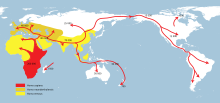Clactonian Man
 |
|
| Geographical range | Afro-Eurasia |
|---|---|
| Period | Lower Paleolithic |
| Dates | c. 424,000 – c. 400,000 BP |
| Type site | Clacton-on-Sea |
| Major sites | Barnham, Nile, Swanscombe Heritage Park |
| Preceded by | Acheulean |
| Followed by | Mousterian |
The Clactonian is the name given by archaeologists to an industry of European flint tool manufacture that dates to the early part of the interglacial period known as the Hoxnian, the Mindel-Riss or the Holstein stages (c. 400,000 years ago). Clactonian tools were made by Homo heidelbergensis.
It is named after 400,000-year-old finds made by Hazzledine Warren in a palaeochannel at Clacton-on-Sea in the English county of Essex in 1911. The artefacts found there included flint chopping tools, flint flakes and the tip of a worked wooden shaft along with the remains of a giant elephant and hippopotamus. Further examples of the tools have been found at sites including Barnfield Pit and Rickson's Pit, near Swanscombe in Kent and Barnham in Suffolk; similar industries have been identified across Northern Europe. The Clactonian industry involved striking thick, irregular flakes from a core of flint, which was then employed as a chopper. The flakes would have been used as crude knives or scrapers. Unlike the Oldowan tools from which Clactonian ones derived, some were notched implying that they were attached to a handle or shaft. Retouch is uncommon and the prominent bulb of percussion on the flakes indicates use of a hammerstone.
...
Wikipedia
